| SERVICES - INDUCTIVE LOOP INSTALLATION
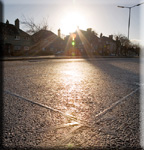 All
our works are carried out by fully trained to Industry Standard
Operatives. Every site is installed to current MCH1540 specification.
Only the highest quality, and to full specification materials
are used on each installation; oxidized bitumen, epoxy resin,
inductive loop cable to the TR2029 specification, ducting,
chambers. Every site installed on completion will be fully
tested for inductance and continuity and working fully to
specification. A fully comprehensive test sheet will be completed
and signed by our senior unit operative and a copy forwarded
to the client. All
our works are carried out by fully trained to Industry Standard
Operatives. Every site is installed to current MCH1540 specification.
Only the highest quality, and to full specification materials
are used on each installation; oxidized bitumen, epoxy resin,
inductive loop cable to the TR2029 specification, ducting,
chambers. Every site installed on completion will be fully
tested for inductance and continuity and working fully to
specification. A fully comprehensive test sheet will be completed
and signed by our senior unit operative and a copy forwarded
to the client.
 |
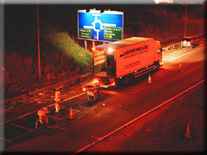 Motorway
Midas Loop - motorway traffic and signal
data obtained from MIDAS (Motorway Incident Detection
and Automatic Signaling) loops. MIDAS detector loops
are placed in every lane of a motorway spaced ideally
every 500m. The loop data are assembled into files which
records count, speed, traffic density and vehicle length,
averaged for each minute of the day. Electronic Counters
then takes this data, including signal settings and
motorway geometry, processes the information in a specified
form and produces detailed graphical outputs of the
behavior of traffic or operational performance of the
controlled motorway systems. Motorway
Midas Loop - motorway traffic and signal
data obtained from MIDAS (Motorway Incident Detection
and Automatic Signaling) loops. MIDAS detector loops
are placed in every lane of a motorway spaced ideally
every 500m. The loop data are assembled into files which
records count, speed, traffic density and vehicle length,
averaged for each minute of the day. Electronic Counters
then takes this data, including signal settings and
motorway geometry, processes the information in a specified
form and produces detailed graphical outputs of the
behavior of traffic or operational performance of the
controlled motorway systems. |
| |
|
 |
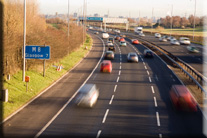 Traffic
Counting Systems - One of the cornerstones
of Automatic Counting System success is the ability
to automate all counting irrespective of distance, location
and environment. The remote electronic counting system
records automatically without human intervention, monitoring
24 hours a day, 7 days a week and 365 days a year. Data
is processed in real-time and a report [daily or weekly]
is sent to the customer automatically. In an event an
alarm has occurred (due to insufficient/excessive count),
our system will automatically notify the customer for
immediate actions to be taken. Traffic
Counting Systems - One of the cornerstones
of Automatic Counting System success is the ability
to automate all counting irrespective of distance, location
and environment. The remote electronic counting system
records automatically without human intervention, monitoring
24 hours a day, 7 days a week and 365 days a year. Data
is processed in real-time and a report [daily or weekly]
is sent to the customer automatically. In an event an
alarm has occurred (due to insufficient/excessive count),
our system will automatically notify the customer for
immediate actions to be taken. |
| |
|
 |
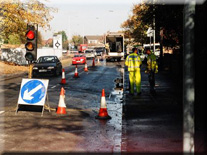 Traffic
Signal Loop - There is something exotic
about the traffic lights that "know" you are
there -- the instant you pull up, they change! How do
they detect your presence? Some lights do not have any
sort of detectors. For example, in a large city, the
traffic lights may simply operate on timers -- no matter
what time of day it is, there is going to be a lot of
traffic. In the suburbs and on country roads, however,
detectors are common. They may detect when a car arrives
at a junction, when too many cars are stacked up at
a junction (to control the length of the light), or
when cars have entered a turn lane (in order to activate
the arrow light). There are all sorts of technologies
for detecting cars - everything from lasers to rubber
hoses filled with air! By far the most common technique
is the inductive loop. An inductive loop is simply a
coil of wire embedded in the road's surface. To install
the loop, they lay the asphalt and then come back and
cut a groove in the asphalt carriageway with a diamond
saw. The wire is placed in the groove, sealed with epoxy
resin, and topped up with oxidized bitumen. Traffic
Signal Loop - There is something exotic
about the traffic lights that "know" you are
there -- the instant you pull up, they change! How do
they detect your presence? Some lights do not have any
sort of detectors. For example, in a large city, the
traffic lights may simply operate on timers -- no matter
what time of day it is, there is going to be a lot of
traffic. In the suburbs and on country roads, however,
detectors are common. They may detect when a car arrives
at a junction, when too many cars are stacked up at
a junction (to control the length of the light), or
when cars have entered a turn lane (in order to activate
the arrow light). There are all sorts of technologies
for detecting cars - everything from lasers to rubber
hoses filled with air! By far the most common technique
is the inductive loop. An inductive loop is simply a
coil of wire embedded in the road's surface. To install
the loop, they lay the asphalt and then come back and
cut a groove in the asphalt carriageway with a diamond
saw. The wire is placed in the groove, sealed with epoxy
resin, and topped up with oxidized bitumen. |
| |
|
 |
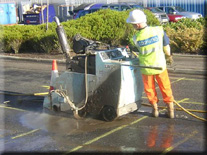 Speed
Detection Speed
Detection, – Another major advance
in technology is Speed Detection loops used for the
‘Speed Camera’ (much to the abhorrence of
drivers) – these operate very similar to the Midas
loop in that the loops are spaced for measurement. The
system operates by the vehicle traveling over the loops,
which calculates an average speed by reading number
plates a set distance apart and measuring the time taken.
As a vehicle drives past the first camera/loop, the
infrared sensors either side of the camera take a reading
of the number plate. Now the vehicle drives past the
second camera/loop and the information is stored again.
From the information received, it can calculate exactly
how long it has taken that vehicle to travel from point
A to B. By calculating distance traveled over time taken
it can work out your average speed within the zone.
The information can then be relayed by transmitting
to a central office via telephone /modem links or recorded
on discs stored in cabinets at the roadside. So if vehicle
speed is in excess of the limit, this is recorded within
the camera, the information is translated very quickly
in order for the Camera to operate and by ‘flashing’
to take a picture of the license plate. We all know
what happens after that…….. |
| |
|
 |
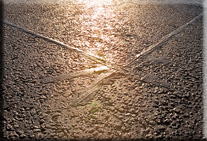 Weight
Detection – Weigh in Motion Sensors
(as opposed to cable) are placed in the carriageway
for Weight Detection. These are most commonly used for
Department of Transport regulations with regards to
vehicle loaded weight. Weight
Detection – Weigh in Motion Sensors
(as opposed to cable) are placed in the carriageway
for Weight Detection. These are most commonly used for
Department of Transport regulations with regards to
vehicle loaded weight. |
| |
|
 |
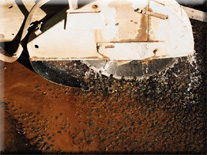 Ice
Detection – Temperature sensors
place in the carriageway and are connected to a weather
station. The information can then be accessed via remote
dialup connection. Detection and warning of adverse
weather enables reactive maintenance, whereas prediction
enables proactive anti-icing operations in advance of
the onset of forecast weather. Ice
Detection – Temperature sensors
place in the carriageway and are connected to a weather
station. The information can then be accessed via remote
dialup connection. Detection and warning of adverse
weather enables reactive maintenance, whereas prediction
enables proactive anti-icing operations in advance of
the onset of forecast weather. |
| |
|
 |
 Bridge
Tolling – Loops installed at bridge
tolls used for control of barriers – something
which we envisage will become more and more in forthcoming
years. The loop detects the vehicle and connects to
the barrier therefore operating the barrier arm. Bridge
Tolling – Loops installed at bridge
tolls used for control of barriers – something
which we envisage will become more and more in forthcoming
years. The loop detects the vehicle and connects to
the barrier therefore operating the barrier arm. |
| |
|
 |
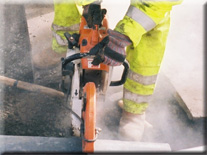 Car
Park Loops – Loops installed at
car parks are used for control of barriers – And
the actual control of available car parking spaces.
The loops actually count the amount of vehicles going
in and going out of the car park thus ensuring that
you there is no blockage within the car park. Car
Park Loops – Loops installed at
car parks are used for control of barriers – And
the actual control of available car parking spaces.
The loops actually count the amount of vehicles going
in and going out of the car park thus ensuring that
you there is no blockage within the car park. |
| |
|
 |
 Bicycle
Loops – Loops are installed on
the carriageway for our eco-friendly bicycle lanes –
These specialised loops work under the same principle
as per the Traffic Signal Loop, only detecting bicycles. Bicycle
Loops – Loops are installed on
the carriageway for our eco-friendly bicycle lanes –
These specialised loops work under the same principle
as per the Traffic Signal Loop, only detecting bicycles. |
| |
|
 |
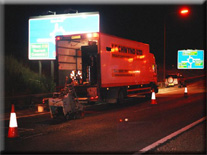 Traffic
Management Services – All areas
of traffic management are available from localized coning
to full Motorway Chapter 8. Road space bookings and
drawings are another service we offer in our turn key
packages. Traffic
Management Services – All areas
of traffic management are available from localized coning
to full Motorway Chapter 8. Road space bookings and
drawings are another service we offer in our turn key
packages.
We manage the complete traffic management
solution - from liaison with the Client to the Highway
Authorities through to the on-site delivery. This includes
site survey; traffic management schematic drawings;
liaison with Local Authorities, Route Managers and Police;
application and receipt of all roadspace bookings, temporary
traffic regulation orders and necessary road closure
permits; method statements & risk assessments. |
| |
|
 |
Maintenance
and Repairs – All of Lochwynd
inductive loop operatives are fully trained in the fault
finding and testing of existing inductive loop arrays.
And a fully detailed site report will be supplied specifying
the maintence works required. We will then carryout
out all maintance and repairs as required, including
all jointing requirements. Fully completed test sheets
are provided to the client for each maintence fault. |
| |
|
 |
Roadside Furniture
– Lochwynd has a range of on site
cabinets to suit all needs of various manufactures counting
equipment we can supply and install specific cabinets
suitable of accepting mains with and internal distribution
board. These cabinets are manuf actured on behalf of
Lochwynd are also suitable for installing eco friendly
solar panels where mains are not a viable option.
|
|



